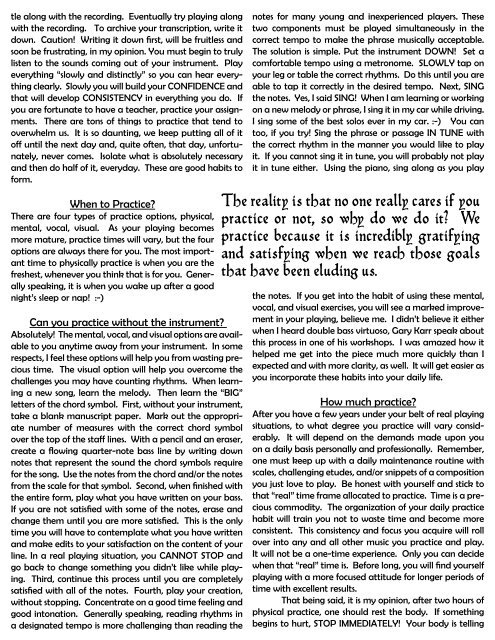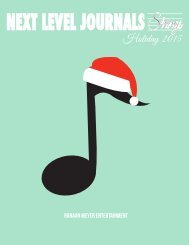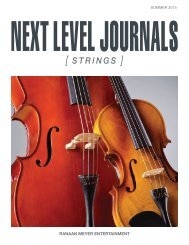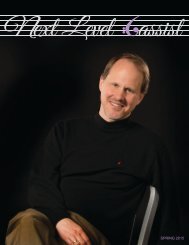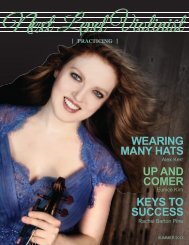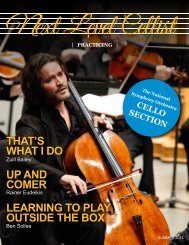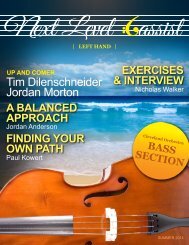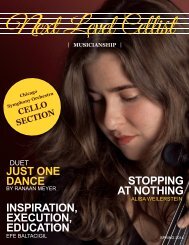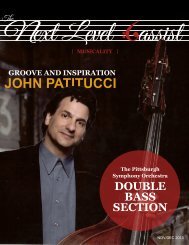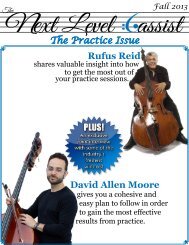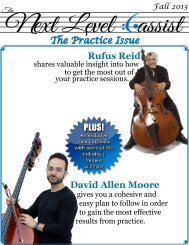The Next Level Bassist - Practicing
Articles by David Allen Moore and Rufus Reid, interviews with recent audition winners, free sheet music by Ranaan Meyer, and more!
Articles by David Allen Moore and Rufus Reid, interviews with recent audition winners, free sheet music by Ranaan Meyer, and more!
You also want an ePaper? Increase the reach of your titles
YUMPU automatically turns print PDFs into web optimized ePapers that Google loves.
tle along with the recording. Eventually try playing along<br />
with the recording. To archive your transcription, write it<br />
down. Caution! Writing it down first, will be fruitless and<br />
soon be frustrating, in my opinion. You must begin to truly<br />
listen to the sounds coming out of your instrument. Play<br />
everything “slowly and distinctly” so you can hear everything<br />
clearly. Slowly you will build your CONFIDENCE and<br />
that will develop CONSISTENCY in everything you do. If<br />
you are fortunate to have a teacher, practice your assignments.<br />
<strong>The</strong>re are tons of things to practice that tend to<br />
overwhelm us. It is so daunting, we keep putting all of it<br />
off until the next day and, quite often, that day, unfortunately,<br />
never comes. Isolate what is absolutely necessary<br />
and then do half of it, everyday. <strong>The</strong>se are good habits to<br />
form.<br />
When to Practice?<br />
<strong>The</strong>re are four types of practice options, physical,<br />
mental, vocal, visual. As your playing becomes<br />
more mature, practice times will vary, but the four<br />
options are always there for you. <strong>The</strong> most important<br />
time to physically practice is when you are the<br />
freshest, whenever you think that is for you. Generally<br />
speaking, it is when you wake up after a good<br />
night’s sleep or nap! :-)<br />
Can you practice without the instrument?<br />
Absolutely! <strong>The</strong> mental, vocal, and visual options are available<br />
to you anytime away from your instrument. In some<br />
respects, I feel these options will help you from wasting precious<br />
time. <strong>The</strong> visual option will help you overcome the<br />
challenges you may have counting rhythms. When learning<br />
a new song, learn the melody. <strong>The</strong>n learn the “BIG”<br />
letters of the chord symbol. First, without your instrument,<br />
take a blank manuscript paper. Mark out the appropriate<br />
number of measures with the correct chord symbol<br />
over the top of the staff lines. With a pencil and an eraser,<br />
create a flowing quarter-note bass line by writing down<br />
notes that represent the sound the chord symbols require<br />
for the song. Use the notes from the chord and/or the notes<br />
from the scale for that symbol. Second, when finished with<br />
the entire form, play what you have written on your bass.<br />
If you are not satisfied with some of the notes, erase and<br />
change them until you are more satisfied. This is the only<br />
time you will have to contemplate what you have written<br />
and make edits to your satisfaction on the content of your<br />
line. In a real playing situation, you CANNOT STOP and<br />
go back to change something you didn’t like while playing.<br />
Third, continue this process until you are completely<br />
satisfied with all of the notes. Fourth, play your creation,<br />
without stopping. Concentrate on a good time feeling and<br />
good intonation. Generally speaking, reading rhythms in<br />
a designated tempo is more challenging than reading the<br />
notes for many young and inexperienced players. <strong>The</strong>se<br />
two components must be played simultaneously in the<br />
correct tempo to make the phrase musically acceptable.<br />
<strong>The</strong> solution is simple. Put the instrument DOWN! Set a<br />
comfortable tempo using a metronome. SLOWLY tap on<br />
your leg or table the correct rhythms. Do this until you are<br />
able to tap it correctly in the desired tempo. <strong>Next</strong>, SING<br />
the notes. Yes, I said SING! When I am learning or working<br />
on a new melody or phrase, I sing it in my car while driving.<br />
I sing some of the best solos ever in my car. :-) You can<br />
too, if you try! Sing the phrase or passage IN TUNE with<br />
the correct rhythm in the manner you would like to play<br />
it. If you cannot sing it in tune, you will probably not play<br />
it in tune either. Using the piano, sing along as you play<br />
<strong>The</strong> reality is that no one really cares if you<br />
practice or not, so why do we do it? We<br />
practice because it is incredibly gratifying<br />
and satisfying when we reach those goals<br />
that have been eluding us.<br />
the notes. If you get into the habit of using these mental,<br />
vocal, and visual exercises, you will see a marked improvement<br />
in your playing, believe me. I didn’t believe it either<br />
when I heard double bass virtuoso, Gary Karr speak about<br />
this process in one of his workshops. I was amazed how it<br />
helped me get into the piece much more quickly than I<br />
expected and with more clarity, as well. It will get easier as<br />
you incorporate these habits into your daily life.<br />
How much practice?<br />
After you have a few years under your belt of real playing<br />
situations, to what degree you practice will vary considerably.<br />
It will depend on the demands made upon you<br />
on a daily basis personally and professionally. Remember,<br />
one must keep up with a daily maintenance routine with<br />
scales, challenging etudes, and/or snippets of a composition<br />
you just love to play. Be honest with yourself and stick to<br />
that “real” time frame allocated to practice. Time is a precious<br />
commodity. <strong>The</strong> organization of your daily practice<br />
habit will train you not to waste time and become more<br />
consistent. This consistency and focus you acquire will roll<br />
over into any and all other music you practice and play.<br />
It will not be a one-time experience. Only you can decide<br />
when that “real” time is. Before long, you will find yourself<br />
playing with a more focused attitude for longer periods of<br />
time with excellent results.<br />
That being said, it is my opinion, after two hours of<br />
physical practice, one should rest the body. If something<br />
begins to hurt, STOP IMMEDIATELY! Your body is telling


